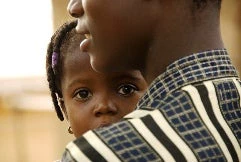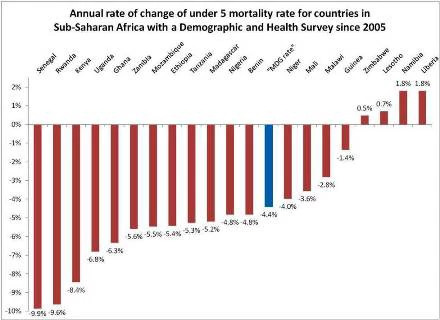
The under-5 mortality (U5MR) measure captures the number of children per 1000 live births who die before their 5th birthday. One of the Millennium Development Goals is a two-thirds decline in U5MR between 1990 and 2015, which would require an annual decline of 4.4 percent per year.
In the 20 countries for which recent data is available, 12 show rates of decline above this “MDG rate.” In particular, Senegal, Rwanda, Kenya, Uganda, and Ghana have experienced extremely large drops at a rate of more than 6 percent per year. This does not necessarily indicate that any particular country will meet the MDG. But it does tell us that the African Renaissance is bringing tangible benefits to the continent’s citizens. Because of this miracle, hundreds of thousands of parents will be spared the agony of the loss of a child.
The acceleration in the decline of child mortality in Sub-Saharan Africa was evident in a 2010 Lancet article, but that article was completed before much of the recent data showing the most dramatic declines was available.
(Click on the graph to see it larger)
One of us (Ritva) used to work on post-conflict Uganda in the 1990s analyzing household survey data on under-5 mortality. The figures were 200 per 1000 live births and even higher. Uganda has witnessed a huge improvement in survival of under 5 year-olds—today Uganda is at 90. In Ethiopia, the second most populous country in Africa, U5MR fell from 123 to 88 between 2005 and 2010. Its 35,000 health extension workers have brought basic preventive and curative health packages to the rural population en masse. Case control studies have shown significant expansion of coverage of malaria interventions (artemisinin-based combination therapy and insecticide-treated bednets) and improvement in sanitation.
In a recent co-authored working paper, one of us (Gabriel) explores what may have driven part of this decline in Kenya, which had the fastest rate of infant (under age 1) mortality, with a drop of 7.6 percent per year between recent Demographic and Health Surveys. A decomposition analysis suggests that the huge increase in ownership of insecticide-treated bednets (ITNs) played a substantial role, by reducing malaria deaths. The paper applies some statistical machinery to the question, but the basic logic is simple.
The infant mortality decline took place chiefly in malaria high-risk zones and was entirely confined to postneonatal mortality (deaths after the 1st month.) Postneonatal mortality is much higher in malaria high-risk zones and much lower among households that own an ITN in malaria high-risk zones (both unconditionally and controlling for a wide variety of other factors). ITN ownership skyrocketed in Kenya between 2003 and 2008, going from 8 to 60 percent of households nationally and reaching 75 percent of households in high-risk zones. Malaria is known not to have any substantial effect on neonatal mortality (deaths during the 1st month), and neonatal mortality does not vary across malaria risk zones and has remained constant over time in Kenya. This collection of facts suggests that ITNs played an important role in the decline of infant mortality in Kenya. This conclusion is also compatible with the findings of small-scale experimental and panel studies on the effects of ITNs on malaria prevalence and mortality.
In the Kenya decomposition analysis, the growth in ITN ownership explains just over half of the infant mortality decline. That still leaves a large chunk of the drop not explained by the factors we have analyzed. In future work, we will examine the broader story of infant and under-5 mortality declines across many countries in the region, which allow us to consider the role of country-wide factors like the broad improvement in living standards that have come with renewed economic growth.




Join the Conversation